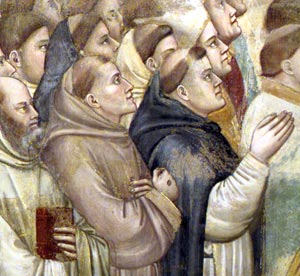 |
 |
| Detail of the "Last Judgement"
in the Scrovegni Chapel, Padua |
 |
Giotto's
relationship with the Franciscans
There is widespread opinion amongst scholars that the special working
relationship between Giotto and the begging monks - in particular with
the powerful Franciscan order - somehow reflects a kind of artistic pilgrimage
sought after and pursued by the Franciscans. This is what brought Giotto
to Padua after having taken him to Assisi and Rimini, during a period
of extraordinary success for the order. As Sante Bortolami maintains in
"Giotto e il suo tempo" (the catalogue for the large exhibition
held in Padua from November 2000 to April 2001), the need for self-celebration
of St. Francis's devotees in that period of sound organisation and of
great influence on urban society, found exceptional means in the constantly
expanding devotion to saints, in intense liturgical/pastoral work and
in preaching. In the period following Ezzelino da Romano's domination
(1237-56), an enormous basilica arose around the humble and primitive
little church of Santa Maria. This grand temple-sanctuary was in honour
of the Franciscan monk Antonio di Lisbona, just as the little church had
been connected to his memory - and it attracted a flood of civic feeling
and popular piety.
The experts' opinion, then, is that the Franciscans invited Giotto to
come to Padua in the early years of the 14th Century and commissioned
him to decorate their magnificent temple in a kind of emulation of their
fellow monks in Umbria and Romagna.
|
| |
 |
| Exterior of the Basilica of St. Anthony, Padua |
 |
A meeting in three stages
Giotto's work in Padua was done in three places
and on behalf of quite different and distinct employers: in the church
and the adjacent Chapter Hall by request of the community of monks that
lived there; in the Palazzo della Ragione by commission from the municipal
authorities for obvious reasons; and finally in the chapel in Santa Maria
dell'Arena, commissioned and paid for by a rich local family, namely the
Scrovegni.
The chronicle of the notary Riccobaldo da Ferrara (written in all probability
around 1312-13, or else 1318, in the opinion of some scholars) or rather,
an addition to it made around 1338, clearly lists the works Giotto had
carried out in the Franciscan churches of Assisi, Rimini and Padua as
well as his paintings in the Palazzo Comunale of the latter city. One
knows that his testimony is credible because in 1293, when he was witness
to nothing less than a miracle, and again between 1308 and 1313, the writer
was living in Padua where he wrote a "large volume of histories"
(magno historiarum volumine).
Not much later - the most probable date is about 1335 - there is a document
written by a judge in Padua, Giovanni da Nono, containing a basic "guide
to the city" in which, describing the vault of the Palazzo della
Ragione at that time, he says that it is resplendent with a cycle of astral
signs magnificently painted by Giotto, the most excellent painter, along
with other stars, pictures and figures, perhaps even his own, portrayed
within the self-same public hall (duodecim celestia signa et septem planete
cum suis proprietatibus .. a Zotho summo pictorum mirifice laborata, et
alia sidera cum speculis et alie figurationes).
The statements of this second source, furthermore, are supported by later
testimony, for example that of the medical doctor Michele Savonarola,
who around 1440, recognised the inseparable relationship of Padua with
Giotto (Zotus pictorum princeps vivit in nostra civitate) and the continuous
flood of artists from all over Italy to admire his works, so that Savonarola
attributes to Giotto not only the decorations of the Scrovegni Chapel
but also the Chapter Hall.
The opinions on the possible traces of these lost works of Giotto's are,
for the most part, highly controversial even today.
Scientific discussions apart, on can say that within a range of time reasonably
contained between 1302-03 and January 1, 1317, Giotto was in Padua for
intense and diversified activities. How many times he was in Padua and
how long he stayed remains a mystery. It is also possible to state that
Giotto's encounter with Padua was prolonged and deepened as well according
to the special intensity of the political, economic and cultural relations
that Padua had with Florence in the years straddling 1300. This constitutes
another key point for understanding the motives connecting Giotto to the
city (cf.. the section "Padua at the time of Giotto").
|












